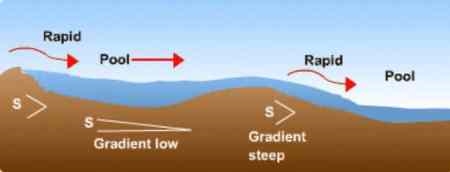Unit-2
Introduction to Open Channel Flow
- Open Channel Flow is defined as fluid flow with a free surface open to the atmosphere. Examples include streams, rivers and culverts not flowing full. Open channel flow assumes that the pressure at the surface is constant and the hydraulic grade line is at the surface of the fluid.

Or
- When water flows through a passage under the force of gravity and atmospheric pressure, the passage is called as open channel. Open channel flow can be said to be as the flow of fluid (water) over the deep hollow surface (channel) with the cover of atmosphere on the top.
- Examples of open channels flow are river, streams, flumes, sewers, ditches and lakes etc. we can be said to be as open channel is a way for flow of fluid having pressure equal to the atmospheric pressure.
- In open channel, flow is due to the difference in potential head caused by downward slope of the bed of the channel. In open channel, flow a uniform slope provide to its bed to maintain the flow of water. Since the pressure is same at the free surface of water throughout its length, flow is not due to pressure difference.
- In most applications, the liquid is water and the air above the flow is usually at rest and at standard atmospheric pressure.
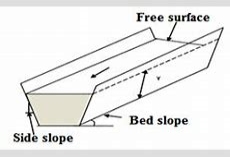
- There exists a free surface between the flowing fluid (usually water) and fluid above it (usually the atmosphere). The main driving force is the fluid weight-gravity forces the fluid to flow downhill.
- Open-channel flow, a branch of hydraulics and fluid mechanics, is a type of liquid flow within a conduit with a free surface, known as a channel. The other type of flow within a conduit is pipe flow.
- In an open channel flow, the free surface allows surface waves to move along the water surface. These waves have an associated velocity field and so may induce velocity fluctuations at the channel bottom, which in turn may influence the bottom stress.
- Most elementary open channel hydraulics is based upon three underlying assumptions: (a) the fluid is homogeneous and incompressible; (b) the flow is steady; and (c) the pressure distribution is hydrostatic at all control sections. Although there are important exceptions, notably the in-homogeneity caused by the entrainment of air in a high-speed flow or the unsteadiness associated with the propagation of flood waves or tidal bores, these assumptions are widely applicable and lead to important simplifications of the conservation equations. In particular, if the pressure distribution is assumed hydrostatic at all control sections, this implies that the streamlines are straight, parallel, and approximately horizontal, and that there are no pressure gradients due to the curvature of the flow.
Sr. No. | Flow Through Pipe | Flow Through Open Channel |
1. | Flow takes place due to difference of pressure between different sections. | Flow takes place due to downward slope of bed of channel. |
2. | Pressure at different section is different. | Pressure at different sections is same and equal to atmospheric pressure. |
3. | Cross section of pipe is always circular | Cross section of open channel may be circular or any other shape. |
4. | Hydraulic gradient line has descending slope towards the direction of flow. | Hydraulic gradient line is coincides with the water surface. |
5. | Flow takes place throughout the full cross sectional area. | Flow does not take place throughout the full cross sectional area if the open channel is a covered channel. |
6. | Roughness co-efficient varies from the low value to a very high value, depending upon the material of the pipe. | Surface roughness varies between wide limits; the hydraulic roughness varies with the depth of flow. |
- Depth Of Flow ‘y’:
- The vertical distance from the lowest point of channel section to the free liquid surface is known as depth of flow.
- The flow depth corresponding to the minimum specific energy for a given discharge in an open channel is known as the critical depth. The critical depth concept is used as the basis for flow characterization, i.e., sub- or supercritical. The flow at critical condition of an open channel is unstable.
- Normal depth is the depth of flow in a channel or culvert when the slope of the water surface and channel bottom is the same and the water depth remains constant. Normal depth occurs when gravitational force of the water is equal to the friction drag along the culvert and there is no acceleration of flow.
- Critical depth is a quantity of fundamental importance to understanding the flow characteristics. If the actual depth is greater than critical depth, then the flow is considered "subcritical". Subcritical flow is "slow flow" and is impacted by downstream conditions.
- Hydraulic depth, abbreviated as dh, also called hydraulic mean depth, is the cross section area of water in a pipe or channel divided by the wetting perimeter.
- The depth of flow is the same at every section of the channel. Uniform flow can be steady or unsteady, depending on whether or not the depth changes with time, (although unsteady uniform flow is rare).
Y = d
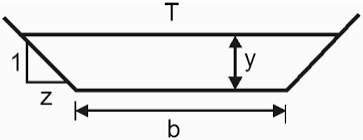
2. Depth Of Flow Section :
- It is the depth of flow normal to direction of flow. Depth of flow section, d Flow depth measured perpendicular to the channel bottom.
Y = d
- The depth of flow is the same at every section of the channel. Uniform flow can be steady or unsteady, depending on whether or not the depth changes with time, (although unsteady uniform flow is rare).
3. Stage:
- It is the elevation or vertical distance of the free surface above a datum.
- In contrast to pipe flows, open channel flows are characterized by a free surface which is exposed to the atmosphere. The pressure on this boundary thus remains approximately constant irrespective of any changes in the water depth and the flow velocity.
4. Top Width ‘T’:
- It is the width of the channel section at the free surface.
- Natural channels are of irregular shape, varying from approximately parabolic to approximately trapezoidal (Chow, 1959). A grassy swale with parabolic cross-section shape has top width T = 6 m when depth y = 0.6 m while carrying storm-water runoff.
T = b + 2zy
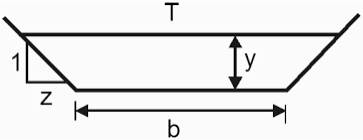
5. Area Of Flow ‘A’:
- It is the sectional area of flow normal to direction of the flow.
A = (b  zy) y
zy) y
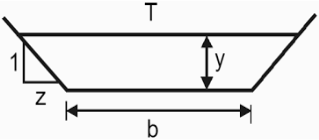
6. Wetted Parameter ‘p’:
- Wetted parameter is the length of line of contact between the liquid and the boundary of the channel.
- In open channel flow, the wetted parameter is defined as the surface of the channel bottom and sides in direct contact with the aqueous body. Friction losses typically increase with an increasing wetted perimeter, resulting in a decrease in head.
P = b + 2y
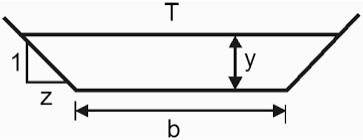
7. Hydraulic Radius ‘R’:
- The hydraulic radius for open channel flow is defined to be the cross sectional area of flow divided by the wetted perimeter.
R = =
=
Where, A is the cross sectional area of flow, P is the portion of the cross sectional perimeter that is wetted by the flow, and R is the hydraulic radius.
8. Hydraulic Depth ‘D’:
- It is the area of flow ‘A’ to the top width ‘T’.
D =  =
= 
9. Sectional Factor For Critical Flow:
- The power of area of flow ‘A’ and square root of hydraulic depth ‘D’ is known as sectional factor. It is denoted by Z
Z = A
- Classification Of Open Channel Based On Boundary And Cross Section:
- Artificial channel Or Man-made Channel:
The channels which are constructed by man are called as artificial or man-made channel. Canal, navigation channels, spillway, road side gutter etc. are artificial channel. Conditions in the case of artificial channels are more controlled and hence correct result can be obtained with mathematical theories.
A channel is a manmade waterway that allows boats and ships to pass from one body of water to another. Channels are also used to transport water for irrigation and other human uses.
Channel is a landform consisting of the outline of the path of a narrow body of water. Canal is a man-made channel for water. Water Channel is a former TV channel in the United States.
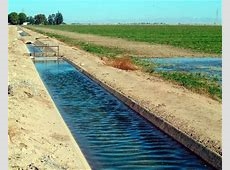
Ii. Natural Channels:
- The channels which are formed naturally in nature are called as natural channel. Stream, rivers, brooks etc. are examples of natural channels. The hydraulic properties of natural channels are varied and its calculation is depends upon actual observation.
- A channel is a wide strait or waterway between two landmasses that lie close to each other. A channel can also be the deepest part of a waterway, or a narrow body of water that connects two larger bodies of water. Some channels were created by glaciers that carved out deep canyons between two landmasses.
- Natural channels are formed by fluvial process and are found across the Earth. These are mostly formed by flowing water from the hydrological cycle, though can also be formed by other fluids such as flowing lava can form lava channels. Stream channel development is controlled by both water and sediment movement.
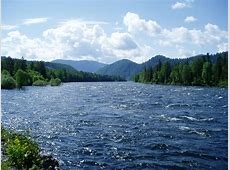
Iii. Prismatic channels:
- Uniform channel cross-section throughout the length. It has Constant bottom slope. Prismatic channels can be triangular, rectangular, parabolic, trapezoidal or circular in shape. Artificial channels are usually prismatic channels.
- Prismatic open channels rigid boundary open channels can be said to be as the open channels with the non-changeable boundaries. While on the other hand if open channel has the boundaries which changes due to scouring action or deposition of sediments, such channels are said to be as loose boundary open channels.
- A channel with unvarying cross-section and the constant bottom slope is called a prismatic channel. All artificial channels are usually prismatic. The rectangular, trapezoid, parabola and circle are the most commonly used shapes of prismatic channels
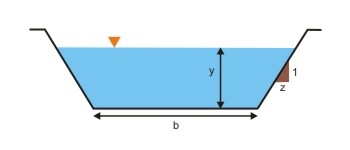
Key Features:
- Uniform channel cross-section throughout the length.
- Constant bottom slope.
- Prismatic channels can be triangular, rectangular, parabolic, trapezoidal or circular.
- Artificial channels are usually prismatic channels.
Iv. Non-prismatic channel:
- If the cross-section of a channel is non-uniform or the bottom slope is not constant, it is called Non-Prismatic Channels.
Or
- A channel with either varying cross-section or the varying bottom slope is called a non-prismatic channel. The natural channels are usually prismatic.
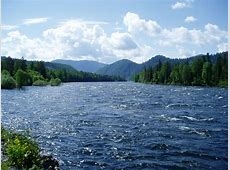
Key Features:
- Non-uniform channel cross-section
- Varying bottom slope.
- Natural channels are usually non-prismatic channel.
v. Rigid Boundary Channel:
- The channels in which the boundary i.e. bed and sides are immovable are called as rigid boundary channel. Lined cannel and sewer if man- made, are example of rigid boundary channel.
Or
- A channel with an immovable bed and sides is known as a rigid boundary channel.
Example: Lined canals, sewers, and non-erodible unlined canals.
- Rigid channels are those in which the boundary is not deformable. The shape and roughness magnitudes are not functions of flow parameters. For example: lined canals and non erodible unlined canals. Channel may undergo changes with space and time depending on type of flow.
Vi. Mobile Boundary Channel:
- The channel whose boundary is made up of loose material which can be eroded or deposited due to the flow in the channel, such channel are called as mobile boundary channel. Alluvial channels are movable boundary channels.
Or
- If a channel boundary is composed of loose sedimentary particles moving under the action of flowing water, the channel is called a mobile boundary channel.
- Example: An alluvial channel is a mobile boundary channel transporting the same type of material comprising the channel perimeter.
- A channel is said to be a mobile boundary channel if the material on the bed and sides of a channel is loose and easily movable due to the flow of water. Analysis of mobile boundary channel is more complicated due to sediment erosion, deposition and resulting in additional resistance to flow.
1) Steady Flow:
It is the depth of flow, the discharge and mean velocity of the flow at any section does not change with respect to time, the flow is called as steady flow.
The steady flow, mathematically, = 0,
= 0,  = 0,
= 0,  = 0
= 0
For in irrigation or water supply canal is example of steady flow.
2) Unsteady Flow:
If the depth of flow, the discharge or mean velocity of flow at any section changes with respect to time, the flow is called as unsteady flow.
For unsteady flow, mathematically, 
 0,
0, 
 0,
0, 
 0
0
Flood flows in the river are the example of unsteady flow.
3) Uniform Flow:
If the depth of flow, discharge and mean velocity flow at a given instant do not change along the length of the channel, the flow is called as uniform flow. Uniform flow and varied flow describe the changes in depth and velocity with respect to distance.
For uniform flow, mathematically,  = 0,
= 0,  = 0,
= 0,  = 0
= 0
4) Non-uniform Flow:
If the depth of flow, discharge and velocity flow at a given instant do not remain same, the flow is called as non-uniform flow.
For non-uniform flow, mathematically, 
 0,
0, 
 0,
0, 
 0.
0.
If the water surface is parallel to the channel bottom flow is uniform and the water surface is at normal depth.
5) Steady Uniform Flow:
When the discharge rate is constant and the section of the channel is same at all sections, the flow is called as steady uniform flow.
Steady flow is characterized by no changes in time. Uniform flow is characterized by the water cross section and depth remaining constant over a certain reach of the channel.
Example: Flow in artificial channels.
6) Laminar Flow And Turbulent Flow:
If Reynolds number is less than or equal to 500, then the flow through channel is called as laminar flow.
R 500
500
If the Reynolds number is greater than or equal to 2000, then the flow through channel is called as turbulent flow.
R  2000
2000
If the Reynolds number is lies in between 500 to 2000, then the flow through channel is called as transitional flow.
500  R
R  2000
2000
In case of channel flow, Reynolds number is
R = 
Where V = mean velocity, R = hydraulic radius =  , v = Kinematic viscosity
, v = Kinematic viscosity
7) Subcritical Flow, Critical Flow And Supercritical flow :
If the Froude number is less than 1, the flow through open channel is called as subcritical flow.
F = 
 1
1
Where V = mean velocity of flow
D = Hydraulic depth of channel = 
A = Wetted area
T = Top width of channel
If the Froude number is equal to 1, the flow through channel is called as critical flow.
F = 1
If the Froude number is greater than 1, the flow through channel is called as super critical flow.
F  1
1
- The velocity of flow at any channel section is not uniform because of frictional resistance along the bed of channel and free surface.
- Theoretically, velocity of flow should be minimum at the topmost point on the vertical centre line, however due to surface tension effect and resistance offered by the air, velocity is reduced at the water surface.
- Maximum velocity occurs at a distance of 0.05 to 0.25 times the flow depth.
- The velocity distribution in channel section depends on various factors-
a) Shape of section
b) Roughness of channel
c) Beds in the channel alignment
The mean velocity of flow in a channel can be computed from the vertical velocity distribution curve obtained by actual measurement.
Average velocity in open channel cross-section is usually the velocity occurs at 0.6y from the free surface.
Average velocity is obtained by taking average of the velocities measured at 0.6y to 0.8y from the free surface.
Line joining the point of equal velocity is known as isovels.
Because of free water surface and frictional resistance along the channel boundary velocity distribution is non-uniform in open channels. To measure velocity of open channel at required depth, Pitot tube or current meter are used. In general, to find average velocity of a particular open channel, velocity at a depth of 0.6 m from free water surface is measured.
Factors Affecting Velocity Distribution in Open Channels:
- Velocity distribution in open channels is mainly depends upon the following factors.
- Shape of the channel section
- Roughness of channel
- Alignment of channel
- Slope of Channel bed
1. Shape of the Channel Section:
Open channels may be naturally formed or artificially developed. Natural open channels do not have any particular shape and they contain irregular sections while artificial channels are provided with certain designed shapes such as rectangular, circular, trapezoidal, triangular etc.
Usually the man made and artificial open channels don't have rectangular cross section. The most common shapes of open channels are circular and trapezoidal.
Contour lines of equal velocities in different shapes of channel sections are shown in below figure.
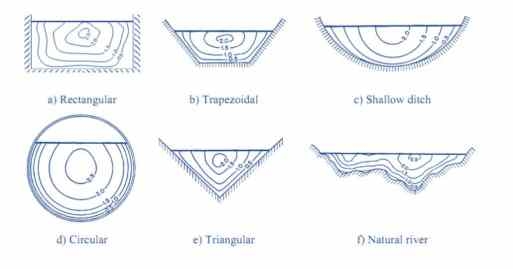
Fig: Contour lines of Equal velocities in Different Channel Sections
- The rectangle, trapezoid, triangle and circle are some of the commonly used shapes in made channels. All natural channels generally have varying cross-sections and consequently are non-prismatic.
2. Roughness of Channel:
Roughness of channel is the measure of amount frictional resistance offered by channel bed material against flow of water. In natural channels, the flow velocity is affected by the presence of large angular boulders as bed material, vegetation, obstructions etc.
If the channel is made of smooth clay or silt, its roughness is very low and water flows faster. In case of artificial channels, smooth finishing is required to maintain required flow velocity. The average velocity in open channels can be calculated using manning’s formula mentioned below.

Where,
V = Average velocity of channel
R = hydraulic radius of channel = Area/Perimeter
S = Slope of channel
n = Manning’s roughness coefficient
- Roughness of channel is the measure of the amount of frictional resistance water experiences when passing over land and channel features. One roughness coefficient is Manning’s n value. Manning’s n is used extensively around the world to predict the degree of roughness in channels. Flow velocity is strongly dependent on the resistance to flow. An increase in this n value will cause a decrease in the velocity of water flowing across a surface.
- Recent studies have found a relationship between hydraulic roughness and salmon spawning habitat; “bed-surface grain size is responsive to hydraulic roughness caused by bank irregularities, bars, and wood debris.
- Channels with progressively greater hydraulic roughness have systematically finer bed surfaces, presumably due to reduced bed shear stress, resulting in lower channel competence and diminished bed load transport capacity, both of which promote textural fining”.
3. Alignment of Channel:
The velocity of flow in channel also depends up on the alignment of channel. If the channel is straight there will be no change is velocity with respect to alignment. In straight channels, maximum velocity is generally occurs at 0.05 to 0.15 m depth from free water surface. If it is sinuous or meandering, the velocity will vary at bends. At bend, due to centrifugal action of flow the velocity becomes more at convex side compared to concave side.
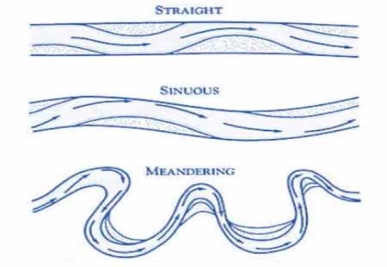
4. Slope of Channel Bed:
- Slope of channel bed or gradient of channel will also effects the velocity of flow in open channels. At steeper gradients, velocity increases while at normal gradients velocity decreases.
- The Slope of bed is used to calculate the shear stress at the bed of an open channel containing fluid that is undergoing steady, uniform flow.
